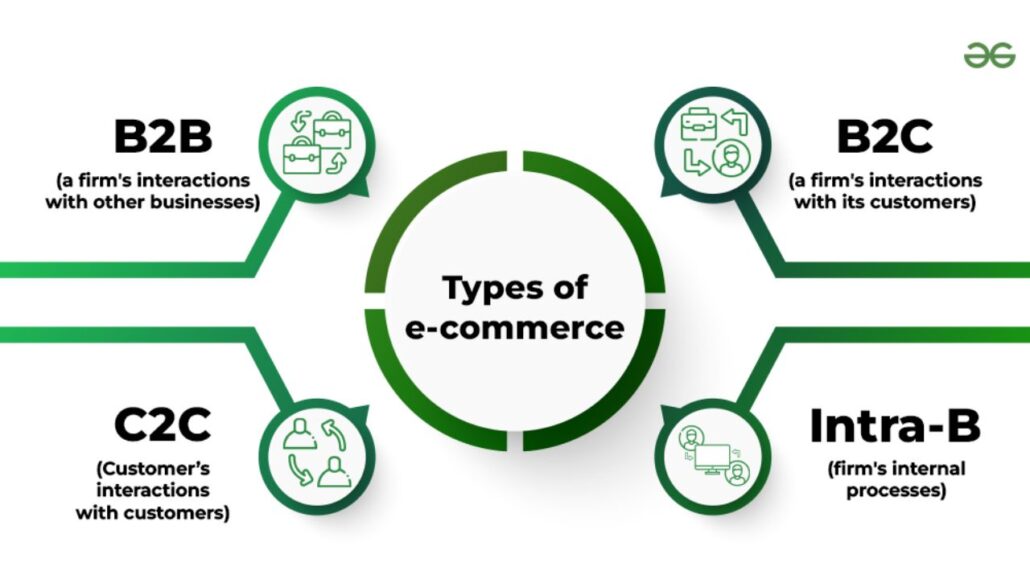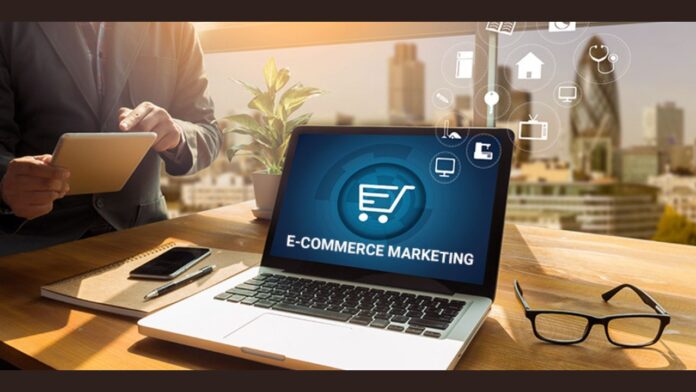E-commerce has revolutionized goods marketing by enabling online platforms for businesses. It facilitates targeted advertising, personalized recommendations, and global reach, altering traditional marketing strategies.
Businesses adapt to digital platforms to engage consumers effectively, optimize customer experiences, and analyze data for informed marketing decisions, driving sales and brand growth.
What Is E-commerce Marketing?
The online buying and selling of goods or services is known as e-commerce. The definition of an e-commerce business can also include tactics like affiliate marketing.
You can use e-commerce channels such as your website, an established selling website like Amazon, or social media to drive online sales.
> The online buying and selling of goods or services is known as e-commerce.
> The definition of an e-commerce business can also include tactics like affiliate marketing.
> You can use e-commerce channels such as your website, an established selling website like Amazon, or social media to drive online sales.
E-commerce Types

There are four distinct types of e-commerce businesses.
Each has its own style of marketing.
B2B
Businesses E-commerce that sell directly to other businesses.
These include SaaS companies like these providers of small business VIPs in Canada.
B2C
Businesses sell directly to the(buyer) customer.
This could include online retailers or subscription resources like Netflix.
C2C
Customers sell to other customers.
This includes the second-hand goods market and resellers operating through auction sites like eBay.
C2B
Customers sell to businesses.
This one sounds counter-intuitive, but we’re talking about contract service provision. Freelancers, product testers, and others might fall under this classification.
The way e-commerce changed the marketing of goods
Accessibility and Convenience
One of the key changes brought about by e-commerce is the unforeseen degree of accessibility and simplicity it offers consumers.
People may now shop for goods from the comfort of their homes, offices, or perhaps while on the go, with just a few clicks or taps. This accessibility has fundamentally altered the way businesses market their goods.
Traditional marketing relied heavily on attracting customers to physical stores through advertisements and promotions.
On the other hand, to access a global audience without requiring a physical storefront. E-commerce has allowed companies to sell their products, and this accessibility profoundly alters the way businesses sell their products.
Traditional marketing places a lot of emphasis on using specials and promotions to draw buyers into physical establishments. Companies can display their products to potential customers worldwide, 24/7, through websites, mobile apps, and online marketplaces.
As a result of this evolution, organizations can connect with a far wider audience and sell what they manufacture.
Targeted marketing and personalization
E-commerce Changed the Marketing, A highly customized and targeted approach is now possible thanks to e-commerce.
Preferences of their customers. Businesses can use statistical analysis and consumer monitoring to analyze customers’ preferences. To increase the likelihood of a transaction, businesses may use this information skillfully to target particular clients in their advertising campaigns.
Providing individualized discounts and offers, delivering targeted messages via email, and suggesting products based on previous purchases are only a few examples of how personalization in e-commerce is used.
Businesses may create incentives that can be more successful and engaging by offering content and promotions following the likes and dislikes of their target market.
Data-Driven Decision Making
e-commerce Changed the Marketing, Making decisions in the conventional marketing sector frequently relies on expertise and intuition. Without hard evidence of their efficacy, businesses would run marketing initiatives, making it difficult to calculate ROI.
On the other hand, data-driven advertising has been made popular by e-commerce. E-commerce companies may track how well their advertising efforts succeed by using various analytics tools and indicators of success.
Consumer demographics, click-through rates, and conversion rates are all covered in this data. The capacity of firms to select the platforms and advertising strategies that will be most successful has improved with the knowledge of this information.
This data-driven strategy helps with budget allocation optimization without also increasing advertising effectiveness.
Websites are Now a Requirement for all Businesses

E-commerce Changed the Marketing, No matter what type of business you run, you need a website. Even for businesses that depend entirely on in-person sales (or did pre-coronavirus), the internet is where people turn when deciding which stores to visit to get what they need.
Demonstrating the authenticity of the company you represent on your website may persuade people to conduct business with you. You are creating a website that used to be complicated and expensive.
But over time, as websites became increasingly essential for all businesses, options for building them also became more affordable and accessible. Now, anyone—no matter their skill level—can build a website using an intuitive website builder.
And for HostGator customers, with the investment of web hosting (something you’ll have to buy anyway to launch a website), you can access a website builder for free. Getting a website running is now affordable and easy.
And the benefits of doing so in the Age of eCommerce are undeniable. E-Commerce introduced new marketing channels. Before the internet, most advertising budgets went to channels like TV, print media, the radio, and billboards.
Businesses still spend money on those things, but now, around half of all advertising budgets go to digital channels. And there are a lot of different digital marketing channels.
Creating an online presence so that it’s easier for potential customers to learn about your brand requires investing in some combination of Search engine optimization (SEO)- Employing tactics that increase the chances of your website showing up for relevant terms in search engines.
Paid search ads- Setting up pay-per-click campaigns to bid for top keywords so your website and products appear on the first page of search engines, especially Google.
Social media marketing – Creating social profiles on different popular platforms and using them to connect with your audience, share information about your brand, and raise your online profile.
Social advertising- Boosting your social following and brand awareness by buying ads on the most popular social platforms and retargeting – Using advertising platforms to serve ads to people who have already shown an interest in your site and products.
Email marketing- Building an email list and sending regular emails to subscribers to stay in touch and build ongoing relationships.
None of these marketing channels existed before eCommerce, and all are now common parts of a modern marketing strategy to boost e-commerce sales.
Marketers Now Have More Data
e-commerce Changed the Marketing, Digital marketing channels can be much more challenging than traditional marketing channels. You can see how often people visit your website, click on your ads, or follow your social profiles.
And more than that, most online advertising platforms have additional data on the characteristics and behaviors of the people taking those actions.
So, what kind of people click on your website you can gain some insights into, like where they’re geographically located and what demographic categories they fall into.
The same information may be used to boost targeting so you may connect with the right people at the proper moment and raise the effectiveness of your advertising campaigns over time.
Brands Must Manage Omnichannel Experiences
E-commerce Changed the Marketing, There are multiple methods to reach your audience, which is beneficial in many ways.
It gives you more opportunities to interact, increase brand recognition, and uncover greater details about your clients. But Practically speaking, it creates serious challenges for businesses. When your brand has a presence across dozens of channels, keeping them all connected is no small feat.
If a customer contacts you on social media, how do you make sure what you learn can be applied to interactions with them on your website or over email? If they click on a link on a mobile device, how do you connect that data to actions they take on their desktop?
Connecting all your different channels is easy but possible. Several tech products now exist to help businesses solve these challenges, but just as importantly, you need a way to organize and use all your information.
Brands of all types and sizes are still trying to navigate effectively, and It’s a complicated process. And it’s a business expectation created by the advent of eCommerce and all the channels and marketing tactics that grew up because of it.
Marketing in the Age of eCommerce Has Its Perks
Sometimes, this transformation feels more like a problem than an improvement.
You have to be in more places now. You have to learn all these different channels and technologies. And between social media and reviews, customers can access information about your brand you can’t control.
On the other hand, there are more ways to interact with them directly and learn what they care about to build trust. You have been given access to more knowledge, which can be used to optimize your approach if you know what your audience likes and responds to.
And as long as your brand works to create great products and deliver amazing customer service, you’ll have a competitive advantage over any brand that isn’t. In a lot of significant ways, E-commerce has already transformed marketing.
As technologies evolve and consumer behavior continues to change with the times, the future of e-dealing will inevitably bring more transformations for marketers to adapt to. You should be able to change with the market if you keep your wits about you and prioritize what those around you care about.
Social Media and Influencer Marketing
E-commerce Changed the Marketing and marketing has been treated as significantly impacted by the development of social media platforms.
Through influencer marketing, using social media influencers to alter the game’s notoriety and legitimacy to promote businesses that have gained popularity through websites like Facebook, Instagram, Twitter, and TikTok, businesses can now create and sustain a robust online presence.
Customers may immediately converse with one another, respond to inquiries, and offer information that will interest their audience.
Bloggers with sizeable and devoted followings can significantly increase their brand’s visibility by delivering things to their consumers genuinely and sympathetically.
Customer Reviews and Social Proof
Customer evaluations and input are now an essential component of the purchasing experience, thanks to e-commerce. Before purchasing, consumers can easily access product reviews and ratings other customers leave.
The ability to obtain social evidence has significantly altered how companies promote their products. Positive customer feedback is a potent recommendation for goods and companies.
By clearly displaying these reviews on their websites and product pages, businesses can benefit from them.
The credibility of a business can be improved, and trust among prospective consumers can be increased by responding to unfavorable reviews and customer complaints transparently and customer-centric.
Mobile Commerce (M-Commerce)
Mobile commerce is known for the widespread use of smartphones and other portable electronics. Nowadays, consumers may easily complete transactions while on the go using websites and mobile applications optimized for mobile use.
M-commerce has altered how firms sell their goods and how consumers shop. To be successful in the M-commerce marketplace, organizations must make arrangements to ensure their apps and web pages are adaptive to mobile devices.
Additionally, when a customer is near a physical store, they can target consumers with promotions and offers using location-based marketing.
In modern marketing strategies, the convenience of M-commerce has made it a critical component.
Expanded Payment Options
A variety of payment options have been made available by e-commerce, making it easier for users to purchase online. Traditional marketing often relied on cash transactions or credit card payments, limiting the scope of potential customers.
However, e-commerce platforms now offer options like digital wallets, buy now, pay later services, and even cryptocurrencies.
These numerous payment alternatives enable businesses to customize their advertising strategies to suit particular payment preferences and serve a broader range of clients.
Multiple payment choices can be a powerful selling point in advertising campaigns. It may be drawing customers who value variety and ease.
Globalization and Market Expansion
Geographical boundaries have been substantially eliminated by e-commerce, allowing companies to expand their markets internationally.
As a consequence of the phenomenon of globalization, companies today have more options regarding growing internationally and diversifying the clientele they serve.
Marketing in the e-commerce era often involves strategies for entering and succeeding in global markets. Localization, international shipping, and currency conversion are just a few examples of factors that companies must consider while developing their marketing plans.
Organizations’ handling of market research and advertising has evolved due to this shift toward a global perspective.
Customer Support and Chatbots
Additionally, customer service and communication have changed as a result of e-commerce. Live chat options and chatbots are becoming commonplace on e-commerce websites, providing customers with quick support for issues or problems.
This real-time engagement improves The total customer experience and helps marketing initiatives. Chatbots have developed into useful tools for automating customer service and answering common questions.
They can also be used for proactive marketing by making tailored product recommendations and special offers based on customer interactions.
This level of engagement took time to achieve in the traditional retail environment.
Enhanced Customer Loyalty Programs
Once limited to punch cards at local stores, loyalty programs have evolved into sophisticated, data-driven systems that reward customers for continued patronage.
Internet-based companies can monitor customer behavior and purchases to develop personalized loyalty programs and rewards. A high level of personalization encourages enduring relationships with customers and repeat sales.
In e-commerce marketing techniques, successful loyalty programs are becoming increasingly vital.
Advantages of E-commerce in Marketing
Why did e-commerce manage to overtake traditional retail and other markets?
There are some distinct advantages that e-commerce provides:
- Availability of data
- Omnichannel marketing
- Less physical restrictions
- 24/7 sales and support availability
- Global reach
- Digitization of products and media
- Social and influencer marketing
- AI and advanced BI (Business Intelligence) technology
- Marketing on the go
- Marketing automation
Whether it’s customer data at your fingertips, a global audience, or the ability to advertise straight to a customer’s mobile, e-commerce extends the reach of a business.
That extends the reach of your marketing efforts, too.
Your ability to target specific users or user groups increases as your reach expands.
Conclusion
e-commerce Changed the Marketing has changed product marketing and how companies advertise and sell their items.
The digital Age has created new options for connecting with customers and promoting engaging shopping experiences through decision-making based on data, social media advertising, transparency, and customization.
How e-commerce might change due to technological advancements will continue to alter how items are sold in the upcoming years. Businesses that want to succeed in this rapidly changing climate must welcome these changes and remain versatile.
FAQ:
How has eCommerce changed marketing?
Small businesses now have a chance to compete with the marketing reach of much larger companies thanks to e-commerce.
Little companies can stand out in crowded markets by employing clever internet advertising campaigns, optimization for SEO, and other digital marketing strategies.
Why is e-commerce important in marketing?
Its primary goals are driving traffic to your website, converting visitors into consumers, and keeping clients after purchase.
A range of tactics are used in e-commerce marketing to increase sales and return on investment (ROI) while reducing spending on brand promotion.
How does eCommerce affect products?
Customers gain from eCommerce’s influence on the marketing mix in that they can download digital goods and services and start using them right away after making a purchase.
Additionally, it is simple and takes only a few seconds to find and exchange product information and reviews.
How has e-commerce changed?
The ability for consumers to purchase whenever and from anywhere has had the most impact on consumer purchasing behavior. They are no longer restricted to purchasing within store hours.
How important are consumer opinions and ratings in e-commerce product marketing?
Customer reviews and ratings are crucial in e-commerce marketing. Favorable testimonials influence prospective purchasers since they increase credibility and confidence. Even unfavorable comments may contain valuable development advice.
E-commerce businesses typically encourage customers to provide reviews and engage in discussion to boost their reputation.
How has e-commerce affected marketing products’ logistics and distribution?
Advancements in logistics and delivery, such as dropshipping, automated warehouses, and same-day or next-day delivery services, result from e-commerce.
To meet the demands of consumers for lightning-fast and convenient shipping, which has since become an essential component of online product promotion, these developments have made it possible for organizations.
What challenges must businesses overcome before using e-commerce to sell their goods?
E-commerce Changed the Marketing, Businesses moving to e-commerce may need help with competition, customer trust, cybersecurity, and rapidly evolving digital technologies.
A flawless online buying experience is important; constantly changing trends are a constant struggle.
How has the marketing of products in e-commerce been affected by mobile technology?
Since an increasing number of consumers utilize smartphones and tablets for online shopping, mobile technology has greatly impacted e-commerce marketing.
Businesses have had to create mobile apps, optimize their websites and advertisements for mobile viewing, and implement mobile payment systems to keep up with this trend.



